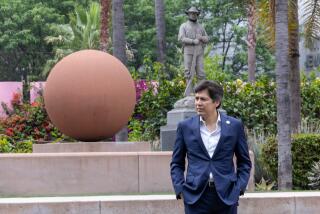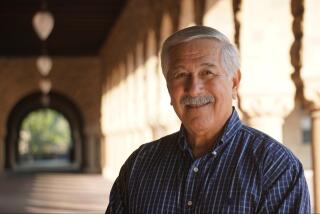William Mason; California Historian, Author
He told us what our little pueblo was like when the 13 colonies of the Atlantic coast created the United States of America.
He told us what developed over the seven decades before and the century and a half after that village joined the new nation.
But most important, he told us long before the word “multiethnic” came to be intertwined with “Los Angeles” that the pueblo-cum-megalopolis had been multiethnic from its very first encampment in 1781.
William M. Mason, veteran California historian and long the curator of Southern California history at the Los Angeles County Museum of Natural History, died Nov. 15 in the city he worked so long to explain. He was 69.
As much a resource as any part of the archive he presided over, Mason steadfastly championed the rich bloodlines of Los Angeles and the influence of each part on the whole.
“Of the 44 original pobladores [colonists] who founded Los Angeles, only two were white,” Mason wrote in an op-ed piece for The Times on Sept. 4, 1975. “Of the other 42, 26 had some degree of African ancestry and 16 were Indians or mestizos [people of mixed Spanish and Indian blood)].”
Asians’ contributions to local history also received Mason’s attention. He curated several special museum exhibitions to illustrate Los Angeles’ multiethnic character over the past centuries--among them “The Blacks of Los Angeles,” “The Japanese of Los Angeles” and “The Chinese of Los Angeles.”
Photographer Toyo Miyatake credited Mason for focusing public attention on his extensive photos of the Manzanar internment camp, where many Japanese Americans from Southern California were held during World War II.
Mason disputed myriad 19th century histories of the Golden State, asserting that they wrongly maligned various ethnicities as lazy, useless and ignorant.
“If history is any judge,” he wrote, “the pobladores were far from useless. In fact, considering their tiny numbers, the early years of their little agricultural colony were remarkably productive. Within four years of its founding, Los Angeles was producing enough grain to enable the governor to halt imports from Mexico. By 1801, the settlement’s grain surplus was large enough for Los Angeles to request permission to export to Mexico itself.”
The True Picture of Chinese Immigrants
Mason also disputed long-held claims that the first Chinese immigrants of the early 1900s frittered away their time in underground passageways that served as opium dens, gambling parlors and hideaways during wars between tongs, or secretive Chinese associations.
So Mason was pleased, but not surprised, when archeologists excavating the area near Union Station (the 19th century Chinatown) during Metro Rail subway construction found no such tunnels or passageways.
He believed that newspapers of that period fictionalized the supposed tunnel network as “scare propaganda,” adding that “people were violently anti-Chinese.”
In addition to various articles and lectures, Mason wrote six books explaining his findings and theories--”The Census of 1790: A Demographic History of California,” “Modest Fortunes” (with Donald Chaput and David Zarate), “Early Dominguez Families and Settlement of the Rancho San Pedro,” “Adobe Interiors of Spanish California,” “Japanese of Los Angeles” and (with Lowell Bean) “The Romero Expeditions.”
Mason, who was with the Museum of Natural History for 31 years, retired in 1993 but had continued writing and lecturing until nearly the end of his life.
Born in Los Angeles, Mason was educated at UCLA. He served in the Marine Corps, earning a Purple Heart in the Korean War, but came to criticize U.S. intervention in Korea and Southeast Asia.
Mason is survived by his wife, Wasana, and stepson, Marvin, of Yasotsorn, Thailand, and by his daughter, Monica Davis of Los Angeles.
Memorial services will be planned, and the family hopes to establish a fund for the preservation of Mason’s documentation of the ethnic history of California.
More to Read
Sign up for Essential California
The most important California stories and recommendations in your inbox every morning.
You may occasionally receive promotional content from the Los Angeles Times.










